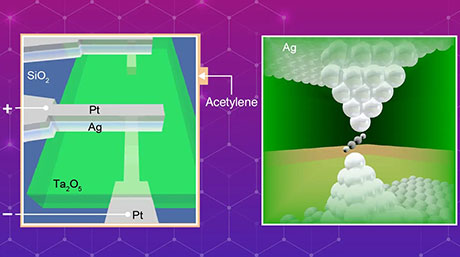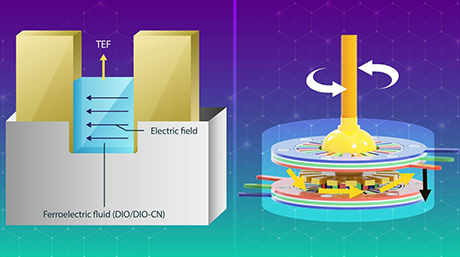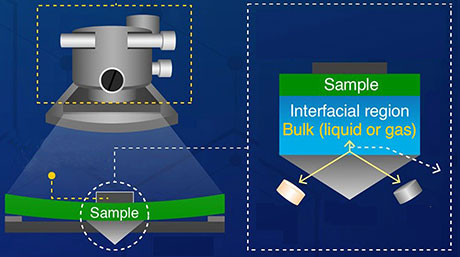Materials Science and Engineering News
Standing Out: Unusual Magnetic Transition in Perovskite Oxide Can Help Boost Spintronics
Transition metal perovskites oxides exhibit several desirable properties, including high-temperature superconductivity and electrocatalysis. Now, scientists at Tokyo Institute of Technology explore the structure and properties of a perovskite oxide, PbFeO3, in anticipation of the unusual charge distribution and exotic magnetic transitions displayed by such systems. They report two of the magnetic transitions, with a distinctive transition above room temperature and look into its causes, opening doors to potential applications in realizing new spintronic devices.
The advent of electronics has revolutionized our lives to an extent where it is impossible to imagine going about our day without relying on an electronic device in some form. What is even more remarkable, however, is that we can improve these devices even further by harnessing the electron's "spin"—a property which makes the electron behave like a magnet—to create memory devices that are faster and use lower power than traditional electronics. Accordingly, the field devoted to this endeavor, aptly called "spintronics", relies on exploiting the "spin state" of the electron. However, controlling spin can be extremely tricky, a fact that often leads scientists on a hunt for materials with ordered spin states.
Their attention has recently turned to lead-based transition metal perovskite oxides, a class of materials represented by PbMO3 (where the "M" indicates 3d transition metal ion), that display rather interesting phase transitions in spin states, making them appealing for practical applications.
In a recent study published in Nature Communications![]() , a team of scientists from China, Japan, Taiwan, Switzerland, Germany, France, and USA, examined the perovskite oxide PbFeO3, a compound that has evaded inspection until now, owing to difficulties in synthesizing samples and resolving its crystal structure. "The perovskite family of PbMO3 exhibits complex charge distributions and RFeO3 (R = rare earth) shows several interesting spin-related properties, such as laser-induced ultrafast spin reorientation, so we expect similarly characteristic charge distribution and rich spin-state transitions for PbFeO3," comment Prof. Masaki Azuma from Tokyo Institute of Technology, Japan and Prof. Youwen Long from Chinese Academy of Science, who led the study.
, a team of scientists from China, Japan, Taiwan, Switzerland, Germany, France, and USA, examined the perovskite oxide PbFeO3, a compound that has evaded inspection until now, owing to difficulties in synthesizing samples and resolving its crystal structure. "The perovskite family of PbMO3 exhibits complex charge distributions and RFeO3 (R = rare earth) shows several interesting spin-related properties, such as laser-induced ultrafast spin reorientation, so we expect similarly characteristic charge distribution and rich spin-state transitions for PbFeO3," comment Prof. Masaki Azuma from Tokyo Institute of Technology, Japan and Prof. Youwen Long from Chinese Academy of Science, who led the study.
Consequently, the team investigated the structure, charge state, and magnetic properties of PbFeO3 using a variety of characterization techniques and backed up their observation with density functional theory (DFT) calculations.
The team found that PbFeO3 crystallized into a unique "charge-ordered" state in which a layer of Pb ions was interleaved by two layers made up of a mixture of Pb and Pb4+ ions in a 3:1 ratio, along the direction of layer stacking (Figure 1). On cooling the sample from high temperature, the team observed two distinct magnetic phase transitions: a weak ferromagnetic transition occurring at 600 K (327°C) characterized by a "canted antiferromagnetic" spin ordering (oppositely directed neighboring spins), and a continuous spin reorientation (SR) transition at 418 K (145°C) (Figure 2).
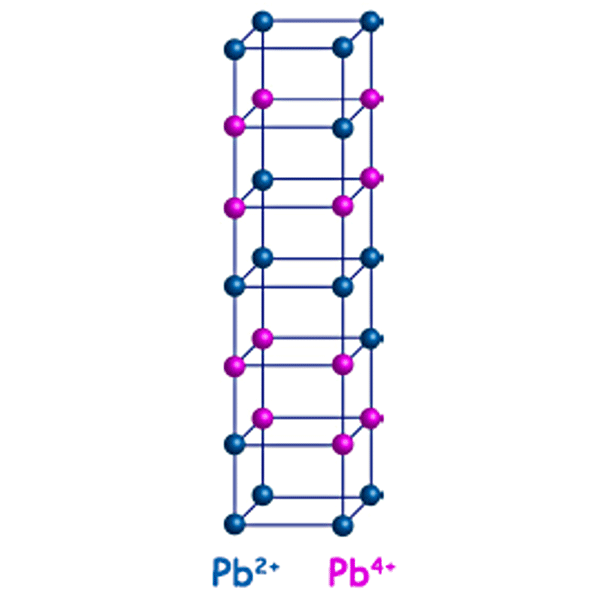
- Figure 1. Sketch of unqiue charge ordering in PbFeO3 comprising two types of differently charged layers
Scientists found that PbFeO3 crystallized into a unique state in which a layer composed of Pb2+ ions was interleaved by two layers comprising a mixture of Pb2+ and Pb ions in a 3:1 ratio.
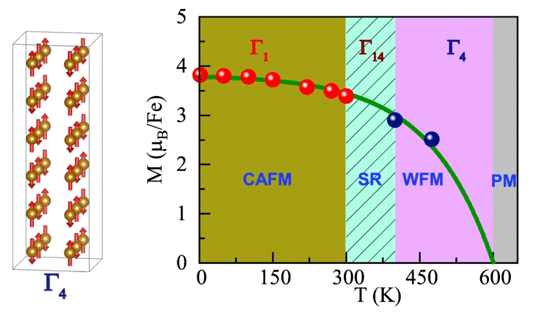
- Figure 2. (Left) Magnetic structure of PbFeO3 between 600 K and 418 K. (Right) Magnetic phase diagram for PbFeO3
On cooling the sample, scientists first observed a weak ferromagnetic transition (WFM) at 600 K, characterized by a canted antiferromagnetic (CAFM) spin ordering, and then a continuous spin reorientation (SR) transition at 418 K.
The SR transition, although common in all RFeO3 perovskites, stood out in this case because it occurred at a much higher temperature compared to those for other perovskites, and unlike the R—Fe magnetic interactions usually identified as the cause for this transition, there was no such counterpart in the case of PbFeO3. To resolve the conundrum, scientists turned to DFT calculations, which revealed that the unique charge ordering in PbFeO3 led to the formation of two Fe3+ "sublattices" with competing energies that, in turn, caused the peculiar SR transition.
The team is thrilled by these findings and their implications for future applications. "Our work provides a new avenue for studying the charge ordering phase and distinctive SR transition with potential applications in spintronic devices due to the high transition temperature and possible tuning," remarks the theoretical team leader, Prof. Hena Das.
One thing's for sure—we're one step closer to making spintronics the reality of tomorrow!
- Reference
| Authors : | Xubin Ye1,2, Jianfa Zhao1,2, Hena Das3,4, Denis Sheptyakov5, Junye Yang5, Yuki Sakai6,3, Hajime Hojo7, Zhehong Liu1,2, Long Zhou1,2, Lipeng Cao1, Takumi Nishikubo3, Shogo Wakazaki3, Cheng Dong1,2, Xiao Wang8, Zhiwei Hu8, Hong-Ji Lin9, Chien-Te Chen9, Christoph Sahle10, Anna Efiminko10, Huibo Cao11, Stuart Calder11, Ko Mibu12, Michel Kenzelmann5, Liu Hao Tjeng8, Runze Yu1,2,4, Masaki Azuma3,6,*, Changqing Jin1,2,13 and Youwen Long1,2,13,* |
|---|---|
| Title of original paper : | Observation of novel charge ordering and spin reorientation in perovskite oxide PbFeO3 |
| Journal : | Nature Communications |
| DOI : | 10.1038/s41467-021-22064-9 |
| Affiliations : |
1 Beijing National Laboratory for Condensed Matter Physics, Institute of Physics, Chinese Academy of Sciences 2 School of Physical Sciences, University of Chinese Academy of Sciences 3 Laboratory for Materials and Structures, Tokyo Institute of Technology 4 Tokyo Tech World Research Hub Initiative (WRHI), Institute of Innovative Research, Tokyo Institute of Technology 5 Laboratory for Neutron Scattering and Imaging, Paul Scherrer Institut 6 Kanagawa Institute of Industrial Science and Technology 7 Department of Advanced Materials and Engineering, Faculty of Engineering Sciences, Kyushu University 8 Max-Planck Institute for Chemical Physics of Solids 9 National Synchrotron Radiation Research Center 10 European Synchrotron Radiation Facility 11 Neutron Scattering Division, Oak Ridge National Laboratory 12 Graduate School of Engineering, Nagoya Institute of Technology 13 Songshan Lake Materials Laboratory |
- Magnetization Reversal achieved at room temperature using only an electric field | Tokyo Tech News
- Changing the color of laser light on the femtosecond time scale | Tokyo Tech News
- Mixed valence states in lead perovskites: A possible avenue to produce next-generation materials | Tokyo Tech News
- New material with ferroelectricity and ferromagnetism may lead to better computer memory | Tokyo Tech News
- Research group unravels 50 year mystery concerning lead chromate | Tokyo Tech News
- Das Lab (Theoretical and Computational Materials Physics Group)
- Azuma Group
- Researcher Profile | Tokyo Tech STAR Search - Hena Das
- Researcher Profile | Tokyo Tech STAR Search - Masaki Azuma
- Researcher Profile | Tokyo Tech STAR Search - Takumi Nishikubo
- Materials Science and Engineering Graduate Major|Education|Department of Materials Science and Engineering, School of Materials and Chemical Technology
- Institute of Innovative Research (IIR)
- Laboratory for Materials and Structures
- Latest Research News
Further Information
Professor Masaki Azuma
Institute of Innovative Research,
Tokyo Institute of Technology
Email mazuma@msl.titech.ac.jp
Tel +81-45-924-5315
